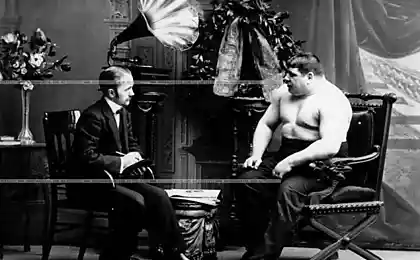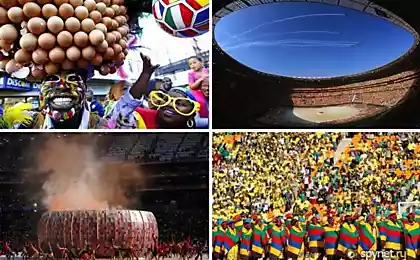959
Stadiums 2010 FIFA World Cup (11 photos)
The coolest stadiums of the world!

1. Stadium "Green Point" in Cape Town
Capacity: 70,000 people
One of several new stadiums built for the 2010 FIFA World Cup, was named after the suburb in which it is located. Built on the site of the old stadium of the same name, the new "Green Point" is located at the foot of Signal and has a short passage from the coast. (Gianluigi Geurcia, Stephane De Sakutin / AFP - Getty Images)

2. Stadium «Nelson Mandela Bay», Port Elizabeth
Capacity: 49 500 people
New high-tech stadium opened June 7, 2009. The first sporting event held here June 16, 2009 - it was a rugby match. (2010 FIFA World Cup OCSA via Getty Images)

3. Stadium Ellis Park Stadium, Johannesburg (also known as «Coca Cola Park»)
Capacity: 60 000
First built in 1928, the stadium for rugby was demolished and rebuilt in 1982. It is named in honor of Dzh.D.Ellisa - member of the Board of Johannesburg. This home stadium of FC «Orlando Pirates» (AFP - Getty Images, Duif du Toit / Gallo Images for 2010 FIFA World Cup OCSA)

4. Stadium Loftus Versfeld, Pretoria
Capacity: 50 000
Originally built in 1906 and significantly updated in 1977, the stadium has undergone minor changes since then. It is named in honor of Robert Owen Loftus Versfeld, who, according to legend, organized in Pretoria soccer matches. Here trains FC «Sundowns». (Alexander Joe / AFP - Getty Images)

5. Stadium Mbombela, Nelspruit
Capacity: 40 000
Brand new stadium built specifically for the World Cup 2010. Despite the strike of the workers and the problems with the soil, the stadium is ready to receive guests. To give the stadium an African atmosphere, all the seats were painted in zebra pattern. (Stephane De Sakutin / AFP - Getty Images)

6. Stadium Free State, Bloemfontein
Capacity: 45 000
It was originally built in 1952. Then, to the Confederations Cup in 2009, has been updated. On the eve of CHMF 2010 in South Africa is a massive urbanization. (Stephane De Sakutin / AFP - Getty Images)

7. Stadium Peter Mokaba, Pietersburg
Capacity: 40 000
The stadium was built on the site of an existing sports complex. It is named after Peter Mokaba Stadium - political activist during the apartheid era and a member of the African National Congress. (Stephane De Sakutin / AFP - Getty Images)

8. Stadium Royal Bafokeng, Rustenburg
Capacity: 42 000
Built in 1999, the stadium is named after the Bafokeng tribe people. That the stadium meets the standards of the 2010 World Cup, there has been some changes. (Stephane De Sakutin / AFP - Getty Images)

9. Stadium Moses Mabhida, Durban
Capacity: 70 000
This stadium was built for the 2010 World Cup on the site of the old stadium «Kings Park», demolished in 2006. The stadium has an arch, similar in design to a new stadium «Wembley Stadium». The stadium is named after the secretary general of the South African Communist Party. (David Rogers / Getty Images, Alexander Joe / AFP - Getty Images)

10. Stadium Soccer City, Johannesburg
Capacity: 94,700
Built in 1987, the first international stadium in South Africa is the largest among those that will host matches of the World Cup 2010. This stadium "saw" the first mass rally after the release of Nelson Mandela. This stadium will be held the first game and the final. Among the major changes: an increase in the upper tier for adding seats and adding 99 more suites (in the general account at the stadium 184 suites). (Alexander Joe / AFP - Getty Images, 2010 FIFA World Cup OCSA via Getty Images)


1. Stadium "Green Point" in Cape Town
Capacity: 70,000 people
One of several new stadiums built for the 2010 FIFA World Cup, was named after the suburb in which it is located. Built on the site of the old stadium of the same name, the new "Green Point" is located at the foot of Signal and has a short passage from the coast. (Gianluigi Geurcia, Stephane De Sakutin / AFP - Getty Images)

2. Stadium «Nelson Mandela Bay», Port Elizabeth
Capacity: 49 500 people
New high-tech stadium opened June 7, 2009. The first sporting event held here June 16, 2009 - it was a rugby match. (2010 FIFA World Cup OCSA via Getty Images)

3. Stadium Ellis Park Stadium, Johannesburg (also known as «Coca Cola Park»)
Capacity: 60 000
First built in 1928, the stadium for rugby was demolished and rebuilt in 1982. It is named in honor of Dzh.D.Ellisa - member of the Board of Johannesburg. This home stadium of FC «Orlando Pirates» (AFP - Getty Images, Duif du Toit / Gallo Images for 2010 FIFA World Cup OCSA)

4. Stadium Loftus Versfeld, Pretoria
Capacity: 50 000
Originally built in 1906 and significantly updated in 1977, the stadium has undergone minor changes since then. It is named in honor of Robert Owen Loftus Versfeld, who, according to legend, organized in Pretoria soccer matches. Here trains FC «Sundowns». (Alexander Joe / AFP - Getty Images)

5. Stadium Mbombela, Nelspruit
Capacity: 40 000
Brand new stadium built specifically for the World Cup 2010. Despite the strike of the workers and the problems with the soil, the stadium is ready to receive guests. To give the stadium an African atmosphere, all the seats were painted in zebra pattern. (Stephane De Sakutin / AFP - Getty Images)

6. Stadium Free State, Bloemfontein
Capacity: 45 000
It was originally built in 1952. Then, to the Confederations Cup in 2009, has been updated. On the eve of CHMF 2010 in South Africa is a massive urbanization. (Stephane De Sakutin / AFP - Getty Images)

7. Stadium Peter Mokaba, Pietersburg
Capacity: 40 000
The stadium was built on the site of an existing sports complex. It is named after Peter Mokaba Stadium - political activist during the apartheid era and a member of the African National Congress. (Stephane De Sakutin / AFP - Getty Images)

8. Stadium Royal Bafokeng, Rustenburg
Capacity: 42 000
Built in 1999, the stadium is named after the Bafokeng tribe people. That the stadium meets the standards of the 2010 World Cup, there has been some changes. (Stephane De Sakutin / AFP - Getty Images)

9. Stadium Moses Mabhida, Durban
Capacity: 70 000
This stadium was built for the 2010 World Cup on the site of the old stadium «Kings Park», demolished in 2006. The stadium has an arch, similar in design to a new stadium «Wembley Stadium». The stadium is named after the secretary general of the South African Communist Party. (David Rogers / Getty Images, Alexander Joe / AFP - Getty Images)

10. Stadium Soccer City, Johannesburg
Capacity: 94,700
Built in 1987, the first international stadium in South Africa is the largest among those that will host matches of the World Cup 2010. This stadium "saw" the first mass rally after the release of Nelson Mandela. This stadium will be held the first game and the final. Among the major changes: an increase in the upper tier for adding seats and adding 99 more suites (in the general account at the stadium 184 suites). (Alexander Joe / AFP - Getty Images, 2010 FIFA World Cup OCSA via Getty Images)
























